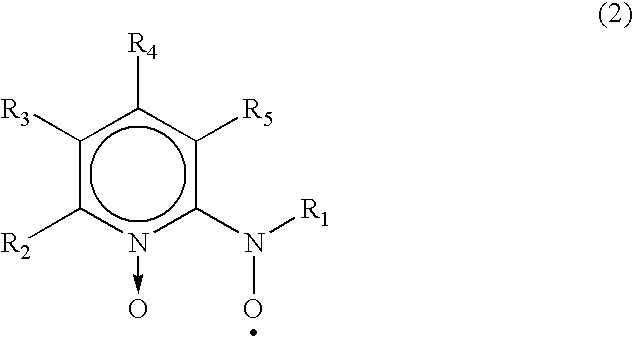Battery and battery electrode
a battery electrode and battery technology, applied in the field of batteries, can solve the problems of inability to act as batteries having a high energy density, inability to rebind dissociated disulfide bonds, and insufficient capacity per unit mass of batteries
- Summary
- Abstract
- Description
- Claims
- Application Information
AI Technical Summary
Benefits of technology
Problems solved by technology
Method used
Image
Examples
example 1
[0086] The nitroxyl radical compound (25 mg) represented by the chemical formula (9), graphite-powders (200 mg), and polytetrafluoroethylene resin binder (25 mg) were mixed in an agate mortar. The mixture which was obtained by dry mixing for about ten minutes was extended by a roller under pressure and a thin electrode plate having the thickness of 215 .mu.m was obtained. After drying the thin electrode plate at 80.degree. C. under vacuum for a night, a battery electrode was obtained by punching the plate in a circle having 12 mm diameter.
[0087] Then, the obtained electrode was dipped in an electrolyte to impregnate the electrolyte into the pore inside the electrode. As the electrolyte a mixture containing electrolytic salt LiPF.sub.6 (1 mol / l) was used composing of ethylenecarbonate and diethylcarbonate (mixing ratio 3:7 by volume). The electrode impregnated with the electrolyte was placed on a current collector of positive electrode and a porous film separator impregnated with the...
example 2
[0093] A battery was produced according to the same method as in Example 1 except for using the nitroxyl radical compound represented by the chemical formula (10) in place of that represented by the chemical formula (9) used in Example 1.
[0094] Discharging tests of the battery produced as described above were carried out according to the same method as in Example 1. As a result of the tests, flat parts of the voltage curves were observed around 2.4 V, which confirmed that the battery was functioning as a battery.
[0095] Furthermore, the voltage of the battery during tests of repeating discharge and charge were measured according to the same method as in Example 1 and as a result of the tests, it was confirmed that it was possible to carry out repeating 10 cycles of discharge and charge and that the battery was functioning as a secondary battery.
examples 3-6
[0096] In Example 3, 4, 5 and 6, batteries were produced according to the same method as in Example 1 except for using the nitroxyl radical compound represented by the chemical formula (11), the chemical formula (14), the chemical formula (16) and the chemical formula (19) respectively, in place of that represented by the chemical formula (9) used in Example 1.
[0097] Discharging tests of the batteries produced as described above were carried out according to the same method as in Example 1. As a result of the tests, flat parts of the voltage curves were observed in every test, which confirmed that the batteries were functioning as batteries.
[0098] Furthermore, the voltages of the batteries during the tests of repeating discharge and charge were measured according to the same method as in Example 1 and as a result of the tests, it was confirmed that it was possible to carry out repeating 10 cycles of discharge and charge and that the batteries were also functioning as secondary batte...
PUM
 Login to View More
Login to View More Abstract
Description
Claims
Application Information
 Login to View More
Login to View More - R&D
- Intellectual Property
- Life Sciences
- Materials
- Tech Scout
- Unparalleled Data Quality
- Higher Quality Content
- 60% Fewer Hallucinations
Browse by: Latest US Patents, China's latest patents, Technical Efficacy Thesaurus, Application Domain, Technology Topic, Popular Technical Reports.
© 2025 PatSnap. All rights reserved.Legal|Privacy policy|Modern Slavery Act Transparency Statement|Sitemap|About US| Contact US: help@patsnap.com



